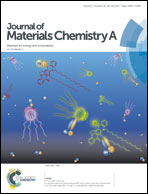All in one porous material: exceptional sorption and selective sensing of hexavalent chromium by using a Zr4+ MOF†
Abstract
We report a new microporous metal–organic framework (MOF) H16[Zr6O16(H2PATP)4]Cl8·xH2O (H2PATP = 2-((pyridin-1-ium-2-ylmethyl)ammonio)terephthalate), denoted as MOR-2 (metal organic resin-2). MOR-2 represents the first Zr4+-terephthalate MOF with an 8-connected net and also the first example where a bulky functional group was introduced into the terephthalate scaffold prior to the MOF synthesis. MOR-2 shows extraordinary capability to rapidly capture (within 1 min) hexavalent chromium with a sorption capacity up to 194 mg Cr(VI) per g, which far exceeds those reported for the known Cr(VI) sorbents. Moreover, MOR-2 in its composite form with alginic acid (HA) can be utilized in ion exchange columns, which are highly efficient for the removal of Cr(VI) from aqueous solutions including industrial waste samples and also can be regenerated and reused several times with minimal loss (<20%) of their capacity. Besides an excellent sorbent, MOR-2 is also a highly efficient sensor for real time detection of Cr(VI) species as revealed by fluorescence titration experiments in acidic aqueous media. The Cr(VI) detection limits were found as low as 4 ppb, while the system exhibited excellent sensitivity when real world, instead of standard, samples were employed. Thus, the MOR-2 material is a unique example combining both excellent sorption and exceptional luminescence sensing of Cr(VI) species in aqueous solutions.



 Please wait while we load your content...
Please wait while we load your content...